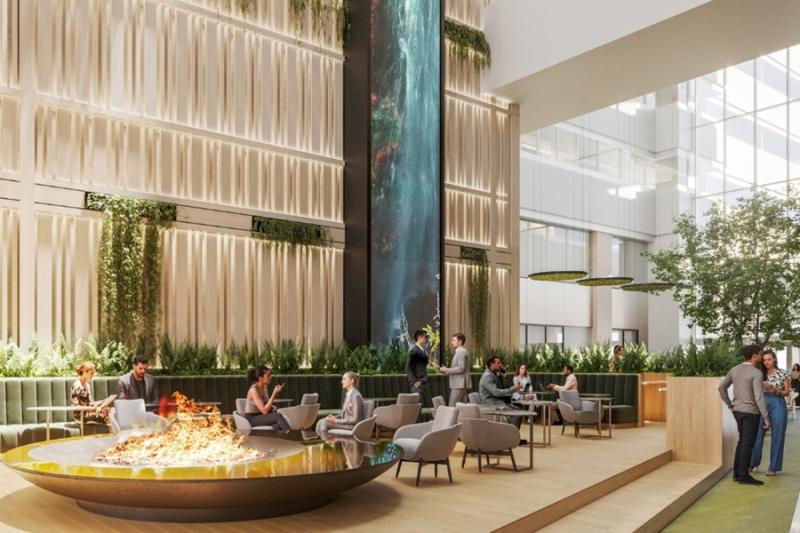
GWL Realty Advisors (GWLRA) started completing quarterly external valuations of its multimillion-square-foot office portfolio -- as well as monthly internal valuations -- after the onset of the COVID-19 pandemic.
That policy has continued and has paid off for the company, which had 238 properties totalling 51.3 million square feet and valued at $17.9 billion in its industrial, residential, office and retail portfolios as of Sept. 30.
Office currently comprises 27.5 per cent of GWLRA’s real estate portfolio, while executive vice-president of portfolio management Steven Marino said the office allocation within its open-ended funds was around 50 per cent 10 years ago. While GWLRA still has a strong belief in the asset class, it made the call to reduce exposure to the sector.
“We think ultimately our stakeholders are the benefactors of having increased transparency and frequency, which ultimately means that we'll realize valuation changes quicker than many of the market participants might otherwise feel them,” Marino said about the company’s office valuation procedures.
“That's incredibly important for our open-end fund clients who are buying in and out of our fund on the basis of the validity of those mark-to-markets.”
The cost of the additional valuations is negligible in relation to the assets they’re assessing and are well worth the money, Marino added.
Impact of office sector downturn
The outlook for office rents hasn’t been as positive since the onset of COVID, Marino acknowledged. In addition, he noted, rising interest rates increased the cost of capital, and the costs of tenant inducements through building improvements and other policies have doubled or tripled in some cases.
The downturn in the office market, which left some questioning its future survival, led to GWLRA's office book dropping by 50 per cent in value after the pandemic. Many buildings were virtually empty as people worked from home before gradually returning — with the pace picking up this year due to mandates from major employers.
Having stronger performing properties in three other major asset classes enabled GWLRA to withstand the costs of improving and repositioning its office buildings.
A recovery, however, seems to be underway — at least for AAA and renovated class-A buildings. There’s still an 18 per cent national office vacancy rate, but trophy assets in Toronto have a vacancy rate of around four per cent.
Rents in these buildings are starting to rise while the ask for tenant inducements has lessened, Marino said.
“If you have a robust and frequent valuation process, you've been marking that to market. And now the tailwinds that are starting to form in office are actually starting to provide immediate opportunities as we move into current conditions.”
Marino continued: “Our valuation models are ultimately discounted cash flows that are based on longer-term projections for the cost of leasing space — the market rent at which you can affect that leasing.
“If you're able to outperform those assumptions, by the time it takes to lease your space or the costs associated with leasing your space or the rents you can achieve, those become building blocks for how you create value on the path forward.”
What tenants want
Office tenants are looking to enhance the experience for their employees so they want to come instead of working from home. Part of that involves having handy access to public transit to make commuting less painful, while having close proximity to food and beverage offerings is appealing for lunches and after-work activities.
“Our job as owners of assets is to continue to communicate with tenants to have a line of sight of how they're defining value and ensuring that we have an ability to help deliver a real estate offering that meets their needs — both today and ultimately adapting tomorrow to continue to meet their needs so we can retain those tenants,” Marino said.

GWLRA has revitalized Calgary’s Watermark Tower by: revamping its lobby; adding seating areas near elevators; upgrading its fitness centre; offering a tenant lounge; providing a multi-functional conference centre; and including end-of-trip facilities with bicycle parking, maintenance and wash stations, charging stations, lockers and showers.
GWLRA’s head office at 33 Yonge St. in downtown Toronto was recently rebranded as Berczy Square as part of a process involving the modernization of the building’s facade and lobby and the provision of a gym for tenants, bike parking, showers and a change room.
Five new or refreshed restaurants have also opened in Berczy Square.
“Those are commitments that are obviously expensive, but we think they're required in the fullness of what we do as asset managers and investors to be able to ensure that we can continue to drive cash flow and performance through the assets,” said Marino, adding that this approach has to be taken on a building-by-building basis.
That’s where accurate valuations again become valuable.
Adapting to return to office
There’s been a subtraction of 21 million square feet of office space in Canada since the pandemic, according to Marino.
But as more people return to their offices, companies are realizing they might need additional space to accommodate them after shedding square footage earlier in the decade. Having model suites available for immediate occupancy has become valuable for landlords.
“If a tenant signs a five-year lease, you may not be getting the economic return you might want,” Marino said of providing model suites. “But in the event you believe that that office layout is going to be generic enough that it's going to have functionality and utility on the renewal of that tenant, or potential re-leasing of that space five years hence, then you start to think about it over the context of the useful life of those build-outs.”
Building owners are also gaining a better understanding of the expansion rights they can extend to tenants to accommodate future growth, Marino said.







